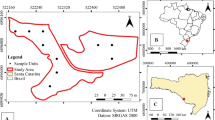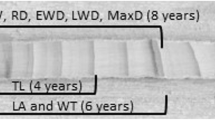Abstract
Pruning is a key silvicultural intervention in order to obtain high quality wood products since it influences the size of the knotty core and the proportion of clear-wood. However, little is known about knotty core size and its distribution through the pruned stem in timber conifers. This paper describes methodologies to predict knotty core profile and form along the pruned stem as tools for helping in the estimation of wood quality before felling. For the first time, defects related to pruned branches and pruning intensity have been considered. Data of Pinus radiata and Pinus pinaster pruned standing trees were collected by non-destructive techniques. Two different approaches based on taper functions were used and adapted to predict knotty core profile, defined by stem diameter over stubs for any given height, in the pruned stem. The two models, which both included pruning intensity, explained 98 and 97 % of variability in the diameter over stubs (average root mean square error of 1.10 and 1.34 cm, respectively). An influence of pruning on stem form, evaluated through a form exponent, was found in both conifers. Higher pruning intensity resulted in stems which were significantly more cylindrical, although this effect disappeared 4 years after the intervention. These results highlight the role of pruning on timber quality, and the importance of assessing the knotty core profile and form before felling trees.


Similar content being viewed by others
References
Alcorn PJ, Bauhus J, Geoff R, Smith B, Thomas D, James R, Nicotra A (2008) Growth response following green crown pruning in plantation-grown Eucalyptus pilularis and Eucalyptus cloeziana. Can J Forest Res 38:770–781
Alegria C (2011) Modelling merchantable volumes for uneven aged maritime pine (Pinus pinaster Aiton) stands establi-shed by natural regeneration in the central Portugal. Ann For Res 54(2):197–214
Álvarez-Álvarez P, Afif E, Cámara-Obregón A, Castedo-Dorado F (2011) Effects of foliar nutrients and environmental factors on site productivity in Pinus pinaster Ait. stands in Asturias (NW Spain). Ann For Sci 68:497–509
Andenmatten E, Fassola H, Letourneau F, Ferrere P, Crechi E (2002) Predicting diameter over stubs in Pinus taeda L. Marion provenance, using taper functions INTA Argentina. RIA 31(3):103–118 (in Spanish)
Arias-Rodil M (2009) Development of a merchantable volume equation for Pinus pinaster in Asturias Master Thesis. High Polytechnical School Lugo, University of Santiago de Compostela (in Spanish)
Bertalanffy LV (1949) Problems of organic growth. Nature 163:156–158
Bertalanffy LV (1957) Quantitative laws in metabolism growth. Q Rev Biol 32:217–231
Bi H (2000) Trigonometric variable-form taper equations for Australian eucalyptus. For Sci 46(3):397–409
Biging GS (1984) Taper equations for second growth mixed conifers of Northern California. For Sci 30:1103–1117
Bredenkamp BV, Malan FS, Conradle WE (1980) Some effects of pruning on growth and timber quality of Eucalyptus grandis in Zululand. S Afr Forest J 114:29–34
Burkhart HE, Tomé M (2012) Modeling forest trees and stands. Springer, Berlin
Burkhart HE, Walton SB (1985) Incorporating crown ratio into taper equations for loblolly pine trees. For Sci 31:478–484
Canga E (2008) Growth and volume production in even-aged Pinus radiata D. Don stands in Asturias. Dissertation, University of Oviedo (in Spanish)
Castedo-Dorado F, Álvarez-González JG (2000) Development of merchantable volume equation for Pinus radiata D. Don in Galicia using a taper function. Invest Agrar Sist Recur For 9(2):253–268 (in Spanish)
Corral RS, Názar-Cháidez JJ, Fernández-Sánchez F (1999) Taper functions fitted to stem profiles of five commercial pine species of the El Salto region, Durango region. Madera y Bosques 5(2):53–65 (in Spanish)
De Montigny L, Stearns-Smith S (2001) Thinning and pruning coastal Douglas-fir near Chilliwack, B.C.: 8 year results. British Columbia Ministry of Forests, Research Branch, Extension Note, 56, pp 8
Durbin J, Watson GS (1951) Testing for serial correlation in least squares regression II. Biometrika 30:159–178
Fang Z, Borders BE, Bailey RL (2000) Compatible volume-taper models for loblolly and slash pine based on a system with segmented-stem form factors. For Sci 46:1–12
Gerrand AM, Neilsen WA, Medhurst JL (1997) Thinning and pruning eucalypt plantations for sawlog production in Tasmania. Tasforests 9:15–34
Gregoire TG, Schabenberger O, Barrett JP (1995) Linear modelling of irregularly spaced, unbalanced, longitudinal data from permanent-plot measurements. Can J For Res 25:137–156
Guindos P, Guaita M (2014) The analytical influence of all types of knots on bending. Wood Sci Technol 48(3):533–552
Hackspiel C, de Borst K, Lukacevic M (2014) A numerical simulation tool for wood grading: model validation and parameter studies. Wood Sci Technol 48(3):651–669
Hevia A (2013) Influence of pruning on the development of Pinus radiata D. Don and Pinus pinaster Aiton stands in Asturias. Dissertation, University of Santiago de Compostela (in Spanish)
Kozak A (1988) A variable-exponent taper equation. Can J For Res 18(11):1363–1368
Kozak A (2004) My last words on taper equations. For Chron 80(4):507–515
Långström B, Hellqvist C (1991) Effects of different pruning regimens on growth and sapwood area of Scots pine. For Ecol Manag 44:239–254
Larson PR (1965) Stem form of young Larix as influenced by wind and pruning. For Sci 11:412–424
Muhairwe CK (1994) Tree form and taper variation over time for interior lodgepole pine. Can J For Res 24:1904–1913
Møller CM (1960) The influence of pruning on the growth of conifers. Foresty 33:37–53
Newnham RM (1988) A variable-form taper function. Information Report PI-X-83. Petawawa National Forest Institute. Forestry Canada, pp 33
Newnham RM (1992) Variable-form taper functions for four Alberta tree species. Can J For Res 22:210–223
Novo N, Rojo A, Álvarez-González JG (2003) Taper and merchantable volume equations for Pinus sylvestris L. in Galicia. Invest Agrar Sist Recur For 12(1):123–136
O'Hara KL (1991) A biological justification for pruning in coastal Douglas-fir stands. WJAF 6(3):59–63
Pinkard EA, Beadle CL (1998) Effects of green pruning on growth and stem shape of Eucalyptus nitens (Deane and Maiden) Maiden. New For 15:107–126
Pompa-García M, Corral-Rivas JJ, Díaz-Vásquez MA, Martínez-Salvador M (2009) Taper and compatible volume equation for Pinus arizonica Engelm. in the southwest of Chihuahua state. Rev Cien For Mex 34(105):117–134 (in Spanish)
Richards FJ (1959) A flexible growth function for empirical use. J Exp Bot 10:290–300
Riemer T, Gadow KV, Sloboda B (1995) Ein Modell zur Beschreibung von Baumschäften (A model to describe tree stems). Allg Forst-u J-Ztg 166(7):144–147 (in German)
Rodríguez F (2005) Production models in poplar of the Cinca Valley. Dissertation, University of Lleida (in Spanish)
Rodríguez F, Molina C (2003) Comparing stem taper functions and analysis of the taper ratio of three poplar clones (Populus x euramericana) in Navarre. Invest Agrar: Sist Recur For 12(3):73–85 (in Spanish)
Rodríguez F, Serrano L, Aunós A (2001) Influence of pruning method on taper function in an 8-year-old poplar plantation owned by Luisa Avanzo, in the middle valley of the Cinca river (Huesca). In: Proceedings book I Symposium on Poplar. Zamora, 9–11 May (in Spanish)
Rojo A, Perales X, Sánchez-Rodríguez F, Álvarez-González JG, von Gadow K (2005) Stem taper functions for maritime pine (Pinus pinaster Ait.) in Galicia (Northwestern Spain). Eur J Forest Res 124:177–186
Rosso F, Ninin P (1998) Variability of log defects in teak (Tectona grandis L.F.) growing at different densities in the Experimental Unit of Ticoporo Forest Reserve, Barinas. Venezuela. Rev Forest Venez 42(2):103–112 (in Spanish)
SAS Institute Inc (2004a) SAS/ETS® 9.1. User’s Guide. Cary, NC: SAS Institute Inc
SAS Institute Inc (2004b) SAS/STAT® 9.1. User’s Guide. Cary, NC: SAS Institute Inc
Schmidt TL, Wardle TD (2002) Impact of pruning eastern redcedar (Juniperus virginiana). WJAF 17(4):189–193
Siddiqui T, Fattakh Nawaz M, Ahmed I (2010) Effect of different pruning intensities on the growth of Acacia nilotica (Kikar). Agrocienc Méx 44(1):93–97
Sutton WRJ, Crowe JB (1975) Selective pruning of radiata pine. New Zeal J For Sci 5(2):171–195
Víquez E, Pérez D (2005) Effect of pruning on tree growth, yield, and wood properties of Tectona grandis plantations in Costa Rica. Silva Fenn 39(3):381–390
Zimmerman DL, Núñez-Antón V (2001) Parametric modelling of growth curve data: an overview (with discussion). Test 10:1–73
Acknowledgments
We thank the Forest Services of the Government of the Principality of Asturias both for access to the forests used in this study and for financial support. Thanks are due to various people from SERIDA (E. Fernández, J.C. Hernández, J. Ordiales, M. Virgilio), CETEMAS (M. Alonso-Graña, E. Álvarez, L. González, M. García, A. Vega), the University of Oviedo and the University of Santiago de Compostela for their participation in the fieldwork. Thank you to Ronnie Lendrum for reviewing the English and FORRISK project (Interreg IV B SUDOE 2007-2013) for its support. Andrea Hevia was supported by the Spanish Ministry of Education and Science through the FPU scholarship program (Reference AP2006-03890).
Author information
Authors and Affiliations
Corresponding author
Rights and permissions
About this article
Cite this article
Hevia, A., Álvarez-González, J.G. & Majada, J. Effects of pruning on knotty core taper and form of Pinus radiata and Pinus pinaster . Eur. J. Wood Prod. 74, 741–750 (2016). https://doi.org/10.1007/s00107-016-1019-0
Received:
Published:
Issue Date:
DOI: https://doi.org/10.1007/s00107-016-1019-0




